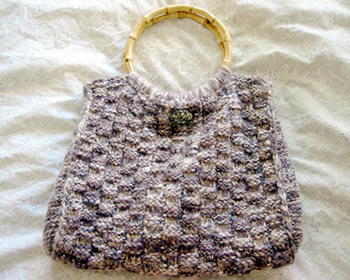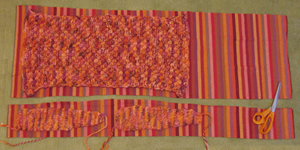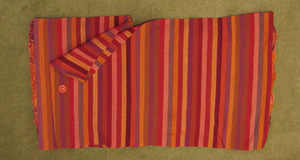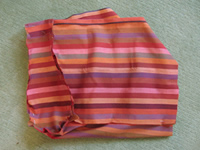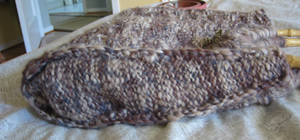Pebbles bag
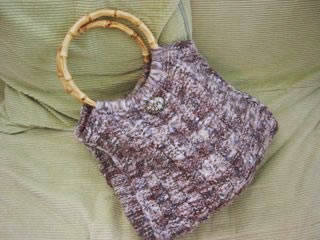
I intended to knit this bag from a pattern where the designer confessed she had been forced to change her mind half way through knitting a hat, and call it a bag. I did not go ahead with my plan, and my pattern is now far removed from that original idea, (except for the handles!). The colours in this wool remind me of the stoney flint beaches on the south coast of England, where I was born and brought up.
InstructionsWith No. 3 needles, cast on 51 stitches, and work 5 rows stocking stitch
starting with a knit row. With right side facing, commence pattern as follows: Row 1: P4, K3, (P5, K3) 5 times, P4
[Editor's note: I chose a textured stitch to best suit the random and nubbly texture of Chunky Print. The muted stone colourway works well, I think, with this basket-weave stitch. If you have a more 'romantic' colourway you may prefer a different pattern. See "blackberry stitch" section below for an alternative four-row pattern to substitute here if you like]. Repeat the six-row pattern 20 times or to desired length, and then the
first 3 rows again. Next row: wrong side facing, Knit to end. Side panels (make 2 the same): Cast on 10sts and work as follows in reverse stocking stitch throughout. Row 1: P10 Continue in reverse st st for 28 more rows. Making up - Cut and construct the lining before sewing the bag
sections together. Construct the lining - do this before attaching the sides to the
bag. Cut the fabric to the width of the bag, using the body section as a guide, and remembering to leave enough for the seams at the edges. Do not cut the fabric to length at this point, unless you are making a simple pocket style bag (see "adapting the pattern"). Press the side panels lightly using a damp cloth. Using the side panels as pattern pieces, cut two fabric side pieces from the fabric you have left over, not forgetting to leave a seam allowance. Fold over the top edge on each piece.
[Editor's note: A lining does not have to be too exact, (the knitting outside is stretchy); it should support the contents of the bag and protect the bag from distorting - I try and make it err just slightly larger than the knitted bag "at rest".] Form the internal pocket section in the lining as follows:
Pin and sew the side panel lining pieces to the main body of the lining.
Inserting the side panels - and completing the bag.
Sew the lining into the bag, slipstitching around the handles and bag mouth. Do not pull your stitches too tight.
Adapting the patternYou may wish to adapt the bag by omitting the sides altogether, either
for simplicity, or to save on wool. Blackberry stitchAn alternative four-row pattern to use in place of the six-row basket weave pattern. [Editor's note: Because of its "one-from-three, three-from-one" nature, this stitch is also know in the Irish tradition as Trinity stitch.]
The four-row pattern is worked over 50 sts using number 2 needles: To complete the main section of the bag, repeat the four-row pattern
26 times or to desired length, and then the first 3 rows again. |
Materials3 x 100g balls (each 100m/109yards) Rowan Chunky Print, colour 078, Pebble Dash, or 081 Shriek. One pair of number 3 needles. Two bamboo-style round handles. Half a metre (or half a yard) of cotton fabric for lining. 1 exotic button oddment (about ¾-1 inch in size.) Tension14sts x 18rows to 4 inches (10cm) on No 3 (6½mm) needles over basket-weave
pattern. CrochetRemember these instructions use UK terms. Double crochet is equivalent to US "single crochet". Size mattersBag is approximately 14in by 12in and 2in deep at the sides. A word on the wool.Chunky Print has been discontinued by Rowan (sadly, as it seemed to have
a pleasing colour range, and knit up quickly and economically). Quilting
fabrics are ideal for the lining; they are inexpensive and come in
a fabulous range of colours. |
Here is my completed Pebbles bag, in the Shriek colourway with blackberry stitch. As a decoration I used a brooch that Alison gave me years ago - the idea being that it was a heart for me to "wear on my sleeve". The lining is an old Kaffe Fassett quilt fabric which turned out to be an improbably good match.

Here is the original Pebbles bag in the Pebble Beach colourway with basket weave stitch. The brooch decoration, like the heart above, tones so well with the wool that it provides a very subtle effect on the bag.
